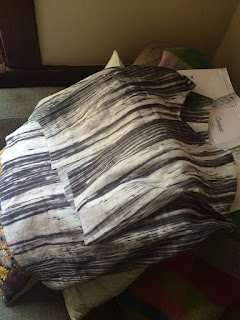This project started after I saw the most amazing refashioned denim Tamarack Jacket and became enamored with it. I'd liked the Grainline Tamarack jacket when it came out, but the longer, color-blocked denim version was what convinced me that I had to make it pronto. As much as I would have liked to recreate that version, I wasn't in a time in my life where I could devote quite that much work to one make, so I took a number of shortcuts. All of which resulted in a coat that isn't anywhere near as perfect as its inspiration, but is easily my most-worn me-made, since I have used it as my primary coat since (almost) completing it.
To approximate the look while saving some time, I bought some of the Art Gallery Denim studio fabric in the Fading Darts pattern. I'd been interested in the denim studio fabrics since they were released but had been unable to find them in person to see what they were like. I ordered a swatch of this one as well as another from Fabric.com to see if I should invest in the full yardage. Of course, it then took me over a month to fully commit to the idea of sewing this jacket, by which time the Fading Darts pattern was sold out at Fabric.com. So I ordered my yardage from Hawthorne Threads instead since they still had some in stock. The Denim Studio fabrics do look like a printed denim but have the weight of a quilting cotton, making this project far more manageable for my machine.
I was planning to make the lining a patchwork of scraps of leftover Nani Iro brushed cotton. However, it turned out that my scraps were very large, so, with a little careful pattern piece placement, I was able to get each individual piece from a single scrap and skip the patchwork. I made my bias strips from the denim fabric and also used bias binding for the seam allowances.
I used bamboo batting from Stonemountain and Daughter Fabrics. I'm still not sure that this was the right decision. I wanted something lighter than wool for the Bay Area climate. However, the bamboo batting is supposed to shrink when washed and can't be prewashed, so I will either decide to be okay with the batting shrinking or only dry clean this jacket. (Of course, I forgot about that and marked a bunch of quilting lines on the lining with washable marker. They aren't too noticeable, but still.) That being said, I really like the weight and feel of the quilting so I'm happy with that. I followed one of the quilting patterns suggested in the Tamarack pattern (3-inch spaced horizontal lines). Though I thought I was being fairly careful, the quilting lines don't match up at all at center front so I clearly wasn't being careful enough. I did stitch each quilting line twice to give it a little bit more visual emphasis.
I wanted a two-way zipper since I though that I'd need some more movement through the hips than the pattern would allow. Luckily, Stonemountain and Daughter Fabrics had some 30" two-way, open-ended zips in stock. I'd hoped for 28" (largely because that's what the Makery used in the inspiration coat) but was more invested in it being two-way so went for the 30". I think I ended up lengthening the pattern by 8" to match the zip. I followed instructions by What Katie Sews for the zipper mod, since the pattern closes with hook-and-eye fasteners, and bias bound the seam allowances. (Since I still haven't gotten around to hand-stitching these down, they flop around a little awkwardly but I've been too lazy to do so since it doesn't really impact the functionality of the coat.)
Though my jacket doesn't come anywhere close to its amazing inspiration, I still enjoy it and it has made me excited about the idea of sewing other outerwear. I have fabric to make another Tamarack as a gift and have thoughts about making myself another shorter one this fall.























